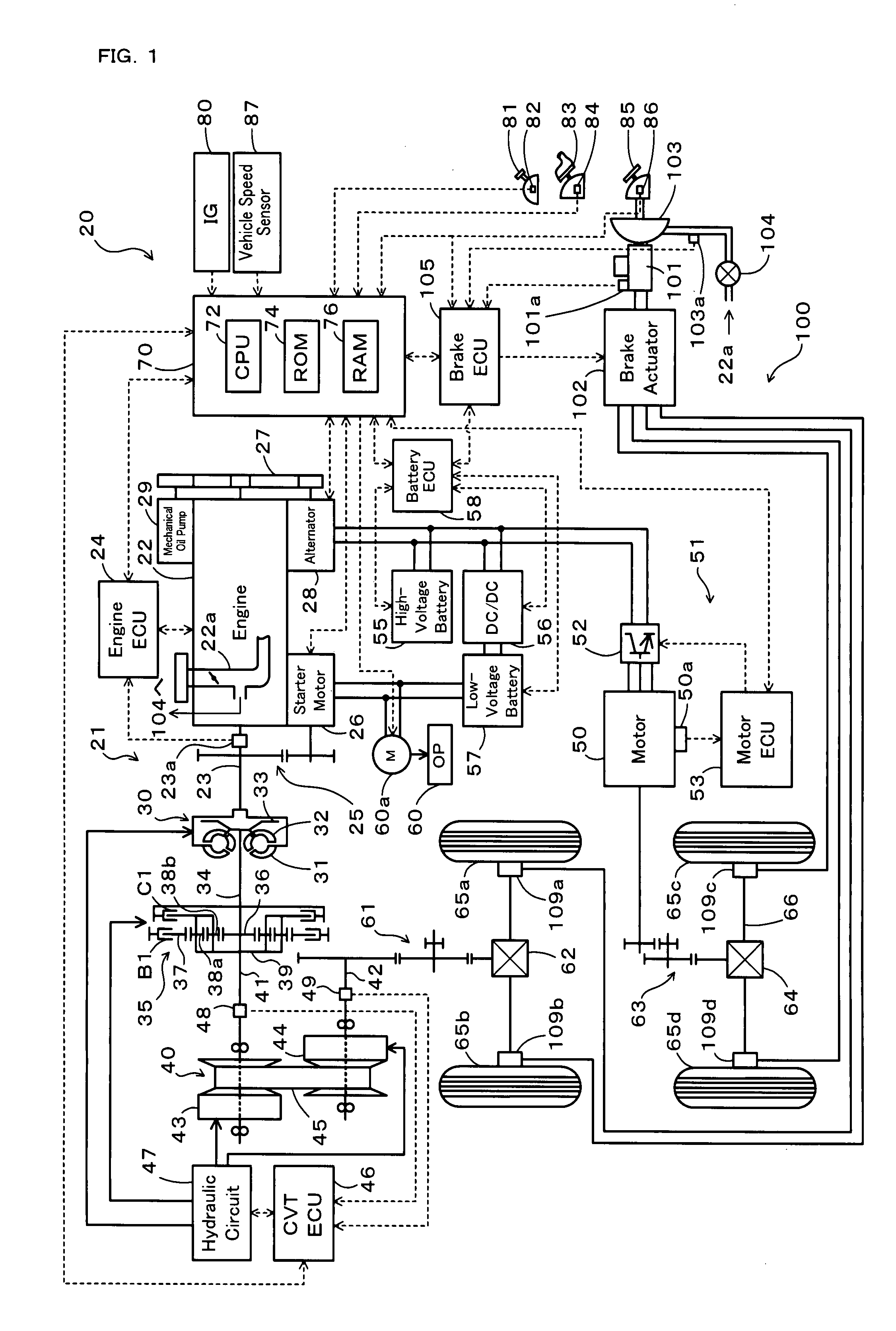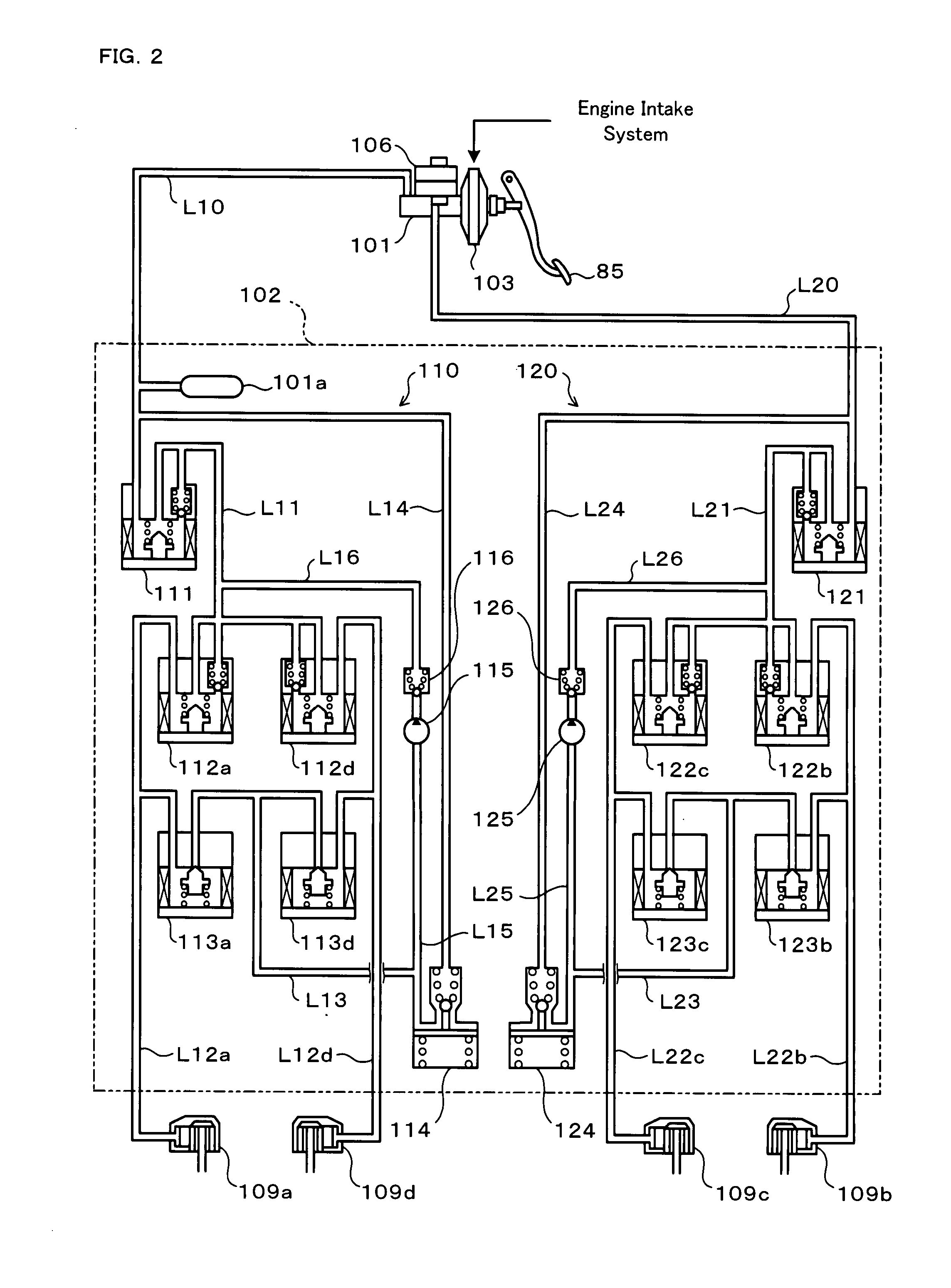[0006] In the vehicle of the invention and the control method of the vehicle, there is a need of preventing the driver from feeling uncomfortable at the time of a braking operation. In the vehicle of the invention and the control method of the vehicle, there is also a need of ensuring satisfaction of a braking force demand required by the driver.
[0009] When the sum of the regenerative braking force produced by the motor and the operational braking force based on the operational pressure is sufficient for a braking force demand required by the driver and set in response to the driver's braking operation, the vehicle of the invention controls the motor and the
fluid pressure braking structure to satisfy the set braking force demand by a total of the regenerative braking force and the operational braking force. When the sum of the regenerative braking force produced by the motor and the operational braking force based on the operational pressure is insufficient for the braking force demand set in response to the driver's braking operation, on the other hand, the vehicle of the invention controls the motor and the
fluid pressure braking structure to satisfy the set braking force demand by a total of the regenerative braking force, the operational braking force, and a braking force based on the increased pressure of the operation fluid. The operational pressure of the operation fluid is produced according to the driver's braking operation and the negative pressure produced by the internal
combustion engine. In the event of no generation of the negative pressure at a stop of the internal
combustion engine or in the event of a decrease in negative pressure by any reason, the generated operational pressure is insufficiently low under application of an equivalent level of the driver's braking operation in the state of decreased negative pressure to the level of the driver's braking operation in the state of non-decreased negative pressure. The insufficient negative pressure may lead to dissatisfaction of the braking force demand by the sum of the regenerative braking force produced by the motor and the operational braking force based on the operational pressure. In such cases, the braking force based on the increased pressure of the operation fluid is additionally used to satisfy the braking force demand. Even when the level of the driver's braking operation in the state of decreased negative pressure is equivalent to the level of the driver's braking operation in the state of non-decreased negative pressure, such braking control ensures satisfaction of the braking force demand required by the driver. The vehicle of the invention thus desirably ensures satisfaction of the braking force demand required by the driver, while effectively preventing the driver from feeling uncomfortable at the time of the driver's braking operation in the state of decreased negative pressure.
[0010] In one preferable embodiment of the vehicle of the invention, the vehicle further includes: an operational
pressure detection unit that detects the operational pressure; a negative
pressure measurement unit that measures the negative pressure produced by the internal combustion engine; and a regenerative braking force setting module that sets a regenerative braking force obtainable by regeneration of the motor in response to the driver's braking operation. In the vehicle, the braking force demand setting module sets the braking force demand based on the detected operational pressure and the measured negative pressure, and the braking control module controls the pressurization unit based on a result of subtraction of the set regenerative braking force and an operational braking force based on the detected operational pressure from the set braking force demand. The vehicle of this aspect ensures accurate setting of the braking force demand required by the driver even in the event of a variation in negative pressure produced by the internal combustion engine. The vehicle of this aspect also adequately regulates the pressurization unit of the fluid pressure braking structure to satisfy the set braking force demand.
[0011] In another preferable embodiment of the vehicle of the invention, the regenerative braking force setting module sets the regenerative braking force obtainable by regeneration of the motor in response to the driver's braking operation based on a rotation speed of the motor and a
state of charge of the accumulator unit. The vehicle of this aspect ensures adequate setting of the regenerative braking force producible by regeneration of the motor in response to the driver's braking operation and effectively uses the regenerative braking force produced by the motor. The effective use of the regenerative braking force desirably saves the energy required for pressurization of the operation fluid by the pressurization unit. The regeneration of the motor may be restricted according to the
state of charge of the accumulator unit. Even when the regenerative braking force produced by regeneration of the motor decreases according to the
state of charge of the accumulator unit, the vehicle of this aspect utilizes the braking force based on the increased pressure of the operation fluid to satisfy the braking force demand required by the driver.
[0013] In still another preferable embodiment of the vehicle of the invention, the internal combustion engine is capable of outputting power to a first axle, and the motor is capable of inputting and outputting power from and to a second axle different from the first axle. The vehicle further includes: a connection disconnection structure that connects and disconnects an output shaft of the internal combustion engine to and from the first axle, and the connection disconnection structure disconnects the output shaft of the internal combustion engine from the first axle and an operation of the internal combustion engine is stopped when a predetermined condition is satisfied. The regenerative braking of the motor with the stopped operation of the internal combustion engine desirably enhances the energy efficiency of the vehicle. In the event of an insufficient level of the negative pressure at the stop of the internal combustion engine, the vehicle of this aspect ensures satisfaction of the braking force demand required by the driver even when the level of the driver's braking operation in the state of decreased negative pressure is equivalent to the level of the driver's braking operation in the state of non-decreased negative pressure. The vehicle of this aspect thus improves the
operability and the safety in the braking state, while enhancing the energy efficiency.
[0015] According to the control method of the vehicle of the invention, the insufficient negative pressure may lead to dissatisfaction of the braking force demand by the sum of the regenerative braking force produced by the motor and the operational braking force based on the operational pressure. In such cases, the braking force based on the increased pressure of the operation fluid is additionally used to satisfy the braking force demand. Even when the level of the driver's braking operation in the state of decreased negative pressure is equivalent to the level of the driver's braking operation in the state of non-decreased negative pressure, such braking control ensures satisfaction of the braking force demand required by the driver. The control method of the vehicle of the invention thus desirably ensures satisfaction of the braking force demand required by the driver, while effectively preventing the driver from feeling uncomfortable at the time of the driver's braking operation in the state of decreased negative pressure.
 Login to View More
Login to View More  Login to View More
Login to View More 


